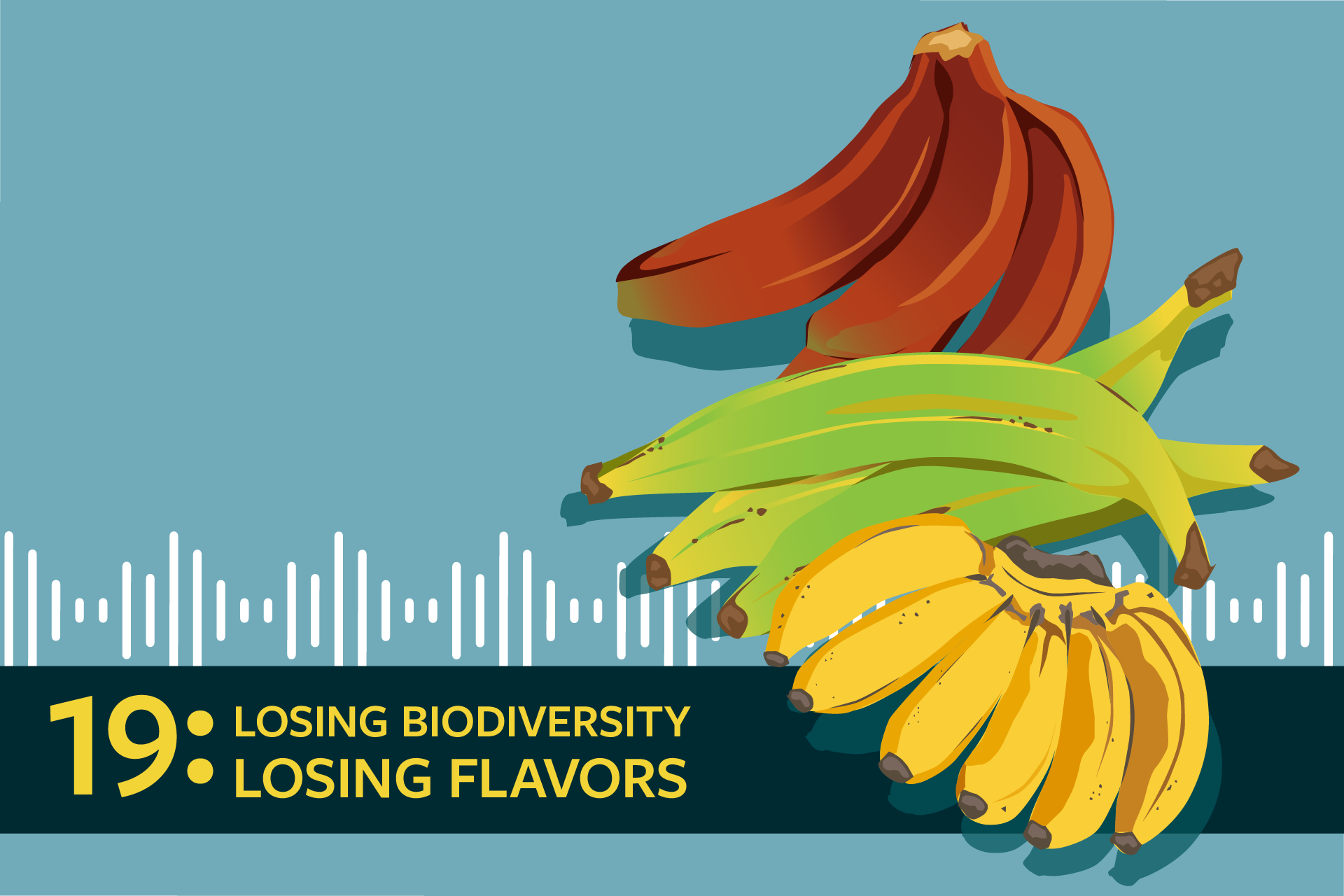Seeds and sovereignty: 8 books on biodiversity in the food system
In the introduction to his 2022 book “Eating to Extinction,” Dan Saladino presents readers with a list of startling facts: “Half of all the world’s cheeses are produced with bacteria or enzymes manufactured by a single company; one in four beers drunk around the world is the product of one brewer; from the USA to China, most global pork production is based around the genetics of a single breed of pig.”
Whether it’s farm animals or the invisible world of microorganisms, genetic uniformity in the food system is part of a larger existential problem. Species populations have fallen by 69 percent since 1970, according to 2022 data from the World Wildlife Foundation, with more than 1 million plants and animals at risk of extinction — an accelerating trend that is now considered a global biodiversity crisis. While many factors are at play, the way we produce food, from land use patterns to pesticides to the standardization Saladino describes, has been identified as the primary driver.
Biodiversity is crucial to a healthy planet, sustaining natural carbon sinks and stable ecosystems. And as FoodPrint explores in a podcast episode titled “Losing Biodiversity, Losing Flavors,” it’s crucial for cultural heritage and good eating, too. To learn more, pick up one of the many books that dive into the confluence of food and biodiversity, including this list — featuring both notable new releases and required reading from some of our most important food systems scholars.
The Hidden Universe: Adventures in Biodiversity
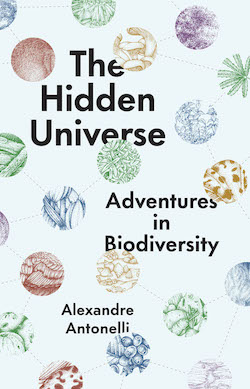
By Alexandre Antonelli
For a primer on biodiversity and why it matters, this 2022 book by botanist Alexandre Antonelli is a great place to start. Antonelli, director of science for London’s Kew Gardens, writes in the preface that he found himself moved to action after becoming “increasingly aware of the rapid pace with which the nature I’ve grown to love so much, through both my early years in Brazil and my later years as a scientist, is disappearing before my eyes.” In “The Hidden Universe,” he lays out the basics with clarity, defining biodiversity in terms of not only genes and species but also the way ecosystems fit together — then explains how this universe all around us is at risk of falling apart. Antonelli’s view is wide, but his call to preserve the world’s biodiversity involves promoting small-scale, traditional farming, reducing food waste, banning PFAS “forever chemicals” and many other recommendations that would transform the food system.
What We Sow: On the Personal, Ecological, and Cultural Significance of Seeds
By Jennifer Jewell

Garden writer Jennifer Jewell recalls the moment she was inspired to start her most recent book, published in 2023: Shortly after the pandemic hit, she and her partner were trying to stock up on seeds and found them almost entirely sold out. “As a gardener, to feel a sense of scarcity in the seed supply was an alarm bell ringing,” she writes. Moving between between science, nature writing, personal essay and her own journal entries, “What We Sow” considers this most rudimentary element of plant biodiversity from many angles: what seeds actually are, how they are dispersed, how we breed, share, legislate and save them and how “seed memory,” as she puts it, makes for the seeds of culture. Jewell also warns of the tangled forces of monocropping, gene patents and GMOs that threaten to dilute this rich world of seeds, “the holders of the genetic ingredients and recipes ensuring biodiversity in our plant lives across ecosystems everywhere.”
Endangered Eating: America’s Vanishing Foods
By Sarah Lohman
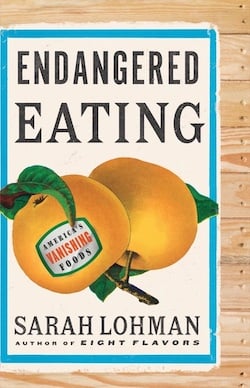
2023’s “Endangered Eating” is primarily a work of culinary and cultural history, but you’ll find biodiversity in the background of nearly every chapter. Food scholar Sarah Lohman illustrates the process of edible species loss (and the role of the “eat it to save it” approach) through eight distinctly American foods and food traditions, all pulled from Slow Food’s Ark of Taste: dates grown only in California’s Coachella Valley, like Abada and Tarbazal, which have been outpaced by standardized varieties grown on large monoculture farms; kupuna kō, the sugarcane varieties unique to the Hawaiian Islands, cast aside during the era of colonial sugar plantations in favor of hardy, high-yield hybrids; heirloom cider apples, which once numbered in the thousands are are now being reclaimed by a growing domestic cider industry. “The reasons these foods may be on the brink of extinction are various,” Lohman writes — but there are hundreds more where these came from, each representing not only a genetic lineage but also a cultural one. The good news: There are just as many people, if not more, working to save them.
Food From the Radical Center: Healing Our Land and Communities
By Gary Paul Nabhan

Ethnobotanist Gary Paul Nabhan has authored dozens of books over his 40-year career, covering topics like seeds, pollinators, regional ecosystems and traditional agriculture. In this 2018 release, Nabhan continues his work exploring the connections between species diversity and cultural richness — and makes a political statement in the process. Despite partisan attacks on environmentalism and climate science, he argues, nearly all of us “have felt increasingly disempowered by the prevalence of top-down decision-making about lands, wildlife, and plants that [we’ve] known and loved.” Each chapter of “Food From the Radical Center” is an example of what he calls “community-based collaboration in biocultural restoration”: farmers revitalizing heritage turkey breeds, for example, or groups monitoring the health of the Delaware River and the Atlantic sturgeon that spawn there. Even if you don’t identify with a centrist stance, you’ll find these parables make the case for a conservation movement with a big tent.
Eating to Extinction: The World’s Rarest Foods and Why We Need to Save Them
By Dan Saladino
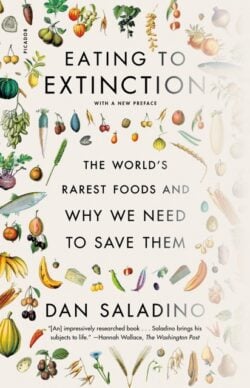
Have you ever heard of murnong? How about skerpikjøt or butarikh? In “Eating to Extinction,” published in 2022, longtime BBC food correspondent Dan Saladino covers these and other culturally significant regional foods at risk of being lost. Murnong, an edible wild root important to the Aboriginal peoples of southern Australia, was decimated by sheep and cattle grazing in the colonial era, and ancestral foraging knowledge barely survived a series of forced displacements at the hands of the British. The wind-dried mutton shank known as skerpikjøt is made in the Faroe Islands from the native Faroe sheep, a tradition that withstood Danish colonization but has lately been threatened by the newfound availability of chicken and pork. On the coast of Mauritania, large-scale industrial fishing in the form of foreign trawlers is impacting grey mullet stocks; the Imraguen people, primary producers of the salted mullet roe called butarikh, are feeling the fallout. Saladino celebrates these foods and dozens more while deftly illustrating how their declines intertwine with colonialism and other forces of cultural erasure — and spotlighting people trying to fight back.
Bread, Wine, Chocolate: The Slow Loss of Foods We Love
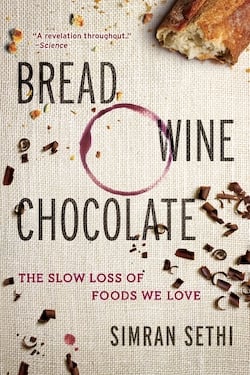
By Preeti Simran Sethi
Near the beginning of her 2015 book “Bread, Wine, Chocolate,” Preeti Simran Sethi dedicates an entire chapter to the theory and practice of taste: the physical and psychological processes, the social role of eating and drinking, what it’s meant to her as a journalist and eater. What does this have to do with biodiversity, you might ask? It’s all part of Sethi’s strategy: taking a gourmand’s approach to demonstrate how a food system that prioritizes consistency and conformity deprives us, people who love to eat, of a world of flavor. She sets out to convince readers of the value of biodiversity work by invoking some of the world’s most beloved ingredients — bread, wine and chocolate, yes, but also beer (starting with a visit to the U.K.’s National Collection of Yeast Cultures) and coffee (which grows in hundred of varieties, though only a few are commercially cultivated). Hear more from Sethi on a recent biodiversity-focused episode of our podcast, “What You’re Eating.”
Who Really Feeds the World? The Failures of Agribusiness and the Promise of Agroecology
By Vandana Shiva
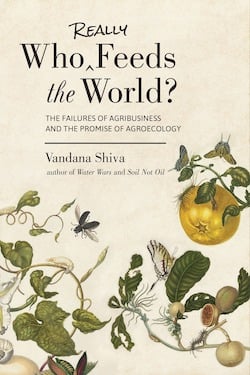
Agrarian activist and radical academic Vandana Shiva has spent much of her career advocating for food sovereignty and peasants’ rights in her home country of India. Among her many publications on the topic of biodiversity is 2016’s “Who Really Feeds the World?” — an effort to unmask and debunk one of the primary forces threatening biodiversity today. Proponents of conventional agriculture, Shiva writes, might try to spin biodiversity loss as a necessary sacrifice for sustaining a huge and growing population, but such “feeding the world” arguments may not hold up to scrutiny. Each chapter tackles one facet of the industrial food system, from pesticides and synthetic fertilizers to corporations and even globalization writ large, showing how each one is failing us and offering her vision of the alternative. Better agricultural practices, Shiva argues, clearly protect the health of the world’s species — and that includes humans.
Braiding Sweetgrass: Indigenous Wisdom, Scientific Knowledge and the Teachings of Plants
By Robin Wall Kimmerer
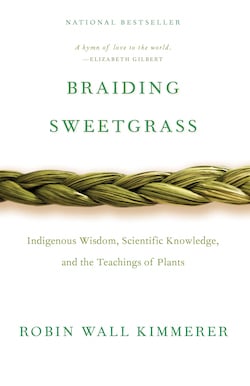
As a botanist and enrolled member of the Citizen Potawatomi Nation, Robin Wall Kimmerer knows that biodiversity is about more than just numbers. Cultivating a multifaceted understanding of the natural world is the reason she founded the SUNY Center for Native Peoples and the Environment, where environmental study draws on both traditional knowledge and modern science, and the force behind “Braiding Sweetgrass,” her 2013 bestseller. Kimmerer writes in the preface that her goal is to braid together three narratives: “Indigenous ways of knowing, scientific knowledge, and the story of an Anishinabekwe scientist trying to bring them together in service to what matters most.” In the pages that follow, she shares insights from her studies in ecology alongside the truths she knows by heart, about family, people and place. Readers will encounter wild strawberries, leeks, fiddleheads, beans, pecans and many more edible species as well as tools for the harvest and home made from native plants like cattails. While this is a book about many things, in Kimmerer’s exploration of how people relate to the land, both food and biodiversity are ever present.
Get the latest food news, from FoodPrint.
By subscribing to communications from FoodPrint, you are agreeing to receive emails from us. We promise not to email you too often or sell your information.
More Reading
Your guide to buying and preparing a heritage turkey or pastured turkey this Thanksgiving
November 18, 2025
How urban orchards improve a community's access to fresh, healthy food
October 30, 2025
The meat industry smeared the Planetary Health Diet. Now its creators are back with more evidence.
October 10, 2025
From Ludacrisp to Cosmic Crisp: How new apples are bred
October 8, 2025
Can recycled soil blends support a more sustainable future?
September 5, 2025
This fall, get involved in one of these campus sustainability initiatives
August 26, 2025
Preserving heirloom date varieties in the Coachella Valley
August 21, 2025
A new book says tech-supported industrial ag will feed the world. Agroecologists would like a word.
July 9, 2025
Use a grocery store trip to teach kids environmental stewardship
July 7, 2025
Can rye growers get consumers and retailers excited about rye?
May 19, 2025

